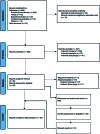A scoping review of arabic self-reported measures of hearing, tinnitus and hyperacusis: Limited quality and quantity
- PMID: 40840944
- PMCID: PMC12392410
- DOI: 10.15537/smj.2025.46.8.20250172
A scoping review of arabic self-reported measures of hearing, tinnitus and hyperacusis: Limited quality and quantity
Abstract
Objectives: To identify Arabic-language self-report measures related to hearing, tinnitus and hyperacusis and evaluate whether they had been validated and cross-culturally adapted following translation from other languages.
Methods: The review followed the Preferred Reporting Items for Systematic reviews and Meta-Analyses extension for Scoping Reviews (PRISMA-ScR guidelines) and searched 5` information sources (PubMed, Embase, Web of Science, PsycINFO and Google Scholar) from their inception to September 2023, identifying all originally developed or translated Arabic self- or parent-report measures related to hearing, tinnitus and hyperacusis. A total of 1,458 records were screened, with only 28 deemed eligible for inclusion.
Results: This review identified 23 measures related to hearing and 5 related to tinnitus and hyperacusis. All but three measures were translated and cross-culturally adapted from other languages. No statistical analysis was performed.
Conclusion: The absence of detailed descriptions of the translation process was a common concern in the identified publications. Despite millions speaking Arabic as their native language, there is a notable lack of high-quality, comprehensive Arabic-language self-report measures for hearing, tinnitus and hyperacusis. Further efforts are needed to develop and cross-culturally adapt validated Arabic measures in accordance with recommended guidelines for research and clinical applications.
Keywords: Arabic self-report measures; audiological self-report measures; validation of self-report measures.
Copyright: © Saudi Medical Journal.
Figures
Similar articles
-
Arabic Aphasia Research Through a Clinical and Linguistic Lens: A Systematic Review of Current Limitations and Future Directions.Int J Lang Commun Disord. 2025 Jul-Aug;60(4):e70064. doi: 10.1111/1460-6984.70064. Int J Lang Commun Disord. 2025. PMID: 40522296 Free PMC article. Review.
-
The development of a novel, standardized, norm-referenced Arabic Discourse Assessment Tool (ADAT), including an examination of psychometric properties of discourse measures in aphasia.Int J Lang Commun Disord. 2024 Sep-Oct;59(5):2103-2117. doi: 10.1111/1460-6984.13083. Epub 2024 Jun 18. Int J Lang Commun Disord. 2024. PMID: 38887796
-
Prevalence of tinnitus and hyperacusis in children and adolescents: a systematic review.BMJ Open. 2016 Jun 3;6(6):e010596. doi: 10.1136/bmjopen-2015-010596. BMJ Open. 2016. PMID: 27259524 Free PMC article.
-
Bone-anchored hearing aids (BAHAs) for people who are bilaterally deaf: a systematic review and economic evaluation.Health Technol Assess. 2011 Jul;15(26):1-200, iii-iv. doi: 10.3310/hta15260. Health Technol Assess. 2011. PMID: 21729632 Free PMC article.
-
Ginkgo biloba for tinnitus.Cochrane Database Syst Rev. 2022 Nov 16;11(11):CD013514. doi: 10.1002/14651858.CD013514.pub2. Cochrane Database Syst Rev. 2022. PMID: 36383762 Free PMC article.
References
-
- World Health Organization. The World Report On HearinG. [Update 2021; 2025 Jan 16]. Available from: https://www.who.int/publications/i/item/9789240020481
-
- Cox RM, Alexander GC.. The International Outcome Inventory for Hearing Aids (IOI-HA): Psychometric properties of the English version. Int J Audiol 2002; 41: 30-35. - PubMed
-
- Hall DA, Zaragoza Domingo S, Hamdache LZ, Manchaiah V, Thammaiah S, Evans C, et al. A good practice guide for translating and adapting hearing-related questionnaires for different languages and cultures. Int J Audiol 2018; 57: 161-75. - PubMed
-
- Alhanbali S, AlJasser A, Aboudi O, Alaqrabawi W, Munro KJ.. Establishing the reliability and the validity of the Arabic translated versions of the Effort Assessment Scale and the Fatigue Assessment Scale. Int J Audiol 2023; 62: 853-358. - PubMed
Publication types
MeSH terms
LinkOut - more resources
Full Text Sources
Medical



